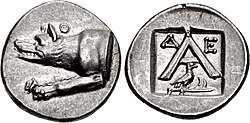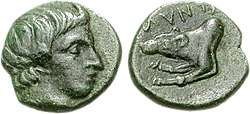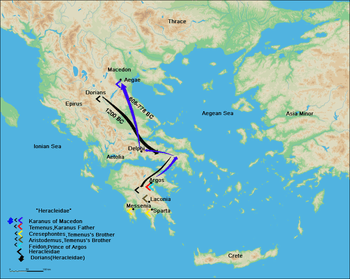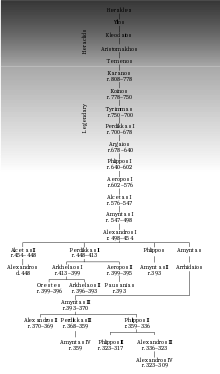Argead dynasty
The Argead dynasty (Greek: Ἀργεάδαι, Argeádai) was an ancient Macedonian royal house of Dorian Greek provenance.[1][2][3] They were the founders and the ruling dynasty of the kingdom of Macedon from about 700 to 310 BC.[4]
| House of Argos | |
|---|---|
 | |
| Parent house | Temenids (Heracleidae) |
| Country | Macedonia, (Ancient Greece) |
| Founded | 808 BC |
| Final ruler | Alexander IV of Macedon |
| Titles | Basileus of Macedonia
King of Persia King of Asia Pharaoh of Egypt Hegemon of the Hellenic League, Strategus Autokrator of Greece |
| Religion | Ancient Greek Religion |
| Estate(s) | Macedonia |
| Dissolution | 310 BC |
Their tradition, as described in ancient Greek historiography, traced their origins to Argos, of Peloponnese in Southern Greece, hence the name Argeads or Argives.[5][6][1] Initially the rulers of the homonymous tribe,[7] by the time of Philip II they had expanded their reign further, to include under the rule of Macedonia all Upper Macedonian states. The family's most celebrated members were Philip II of Macedon and his son Alexander the Great, under whose leadership the kingdom of Macedonia gradually gained predominance throughout Greece, defeated the Achaemenid Empire and expanded as far as Egypt and India. The mythical founder of the Argead dynasty is King Caranus.[8][9]
Origin


The words Argead and Argive derive (via Latin Argīvus[11]) from the Greek Ἀργεῖος (Argeios meaning "of or from Argos"[12]), which is first attested in Homer where it was also used as a collective designation for the Greeks ("Ἀργείων Δαναῶν", Argive Danaans).[13][14] The Argead dynasty claimed descent from the Temenids of Argos, in the Peloponnese, whose legendary ancestor was Temenus, the great-great-grandson of Heracles.[1]
In the excavations of the royal palace at Aegae, Manolis Andronikos discovered in the "tholos" room (according to some scholars "tholos" was the throne room) a Greek inscription relating to that belief.[15] This is testified by Herodotus, in The Histories, where he mentions that three brothers of the lineage of Temenus, Gauanes, Aeropus and Perdiccas, fled from Argos to the Illyrians and then to Upper Macedonia, to a town called Lebaea, where they served the king. The latter asked them to leave his territory, believing in an omen that something great would happen to Perdiccas. The boys went to another part of Macedonia, near the garden of Midas, above which mount Bermio stands. There they made their abode and slowly formed their own kingdom.[16]
Herodotus also relates the incident of the participation of Alexander I of Macedon in the Olympic Games in 504 or 500 BC where the participation of the Macedonian king was contested by participants on the grounds that he was not Greek. The Hellanodikai, however, after examining his Argead claim confirmed that the Macedonian kings were Greeks and allowed him to participate.[17]

Another theory supported by modern scholars, following the ancient author Appian, is that the Argead dynasty actually descended from Argos Orestikon in Macedonia, and that the Macedonian kings claimed a descent from Argos in Peloponnese to enforce their Greekness.[18]
| Periods and Dynasties of Ancient Egypt | ||||||||||||||||||
|---|---|---|---|---|---|---|---|---|---|---|---|---|---|---|---|---|---|---|
|
All years are BC | ||||||||||||||||||
|
Early
|
||||||||||||||||||
|
||||||||||||||||||
|
||||||||||||||||||
|
||||||||||||||||||
|
||||||||||||||||||
|
||||||||||||||||||
|
||||||||||||||||||
|
||||||||||||||||||
|
Ptolemaic (Hellenistic)
|
||||||||||||||||||
|
See also: List of Pharaohs by Period and Dynasty Periodization of Ancient Egypt | ||||||||||||||||||

According to Thucydides, in the History of the Peloponnesian War, the Argeads were originally Temenids from Argos, who descended from the highlands to Lower Macedonia, expelled the Pierians from Pieria and acquired in Paionia a narrow strip along the river Axios extending to Pella and the sea. They also added Mygdonia in their territory through the expulsion of the Edoni, Eordians, and Almopians.[19]
Dynasty
| King | Reign (BC) | Comments |
|---|---|---|
| Caranus | 808–778 BC | Founder of the Argead dynasty and the first king of Macedon. |
| Koinos | 778–750 BC | |
| Tyrimmas | 750–700 BC | |
| Perdiccas I | 700–678 BC | |
| Argaeus I | 678–640 BC | |
| Philip I | 640–602 BC | |
| Aeropus I | 602–576 BC | |
| Alcetas I | 576–547 BC | |
| Amyntas I | 547–498 BC | |
| Alexander I | 498–454 BC | |
| Alcetas II | 454–448 BC | |
| Perdiccas II | 448–413 BC | |
| Archelaus | 413–399 BC | |
| Orestes and Aeropus II | 399–396 BC | |
| Archelaus II | 396–393 BC | |
| Amyntas II | 393 BC | |
| Pausanias | 393 BC | |
| Amyntas III | 393 BC | |
| Argaeus II | 393–392 BC | |
| Amyntas III | 392–370 BC | Restored to the throne after one year. |
| Alexander II | 370–368 BC | |
| Ptolemy I | 368–365 BC | |
| Perdiccas III | 365–359 BC | |
| Amyntas IV | 359 BC | |
| Philip II | 359–336 BC | Expanded Macedonian territory and influence to achieve a dominant position in the Balkans, unified most of the Greek city-states in the League of Corinth under his hegemony. |
| Alexander III | 336–323 BC | Alexander the Great, the most notable Macedonian king and one of the most celebrated strategists and rulers of all time. Alexander at the top of his reign was simultaneously King of Macedonia, Pharaoh of Egypt, King of Persia and King of Asia. |
| Antipater | 334–323 BC | Regent of Macedonia during the reign of Alexander III. |
| Philip III Arrhidaeus | 323–317 BC | Only titular king after the death of Alexander III. |
| Alexander IV | 323–310 BC | Son of Alexander the Great and Roxana. Served only as a titular king and was murdered at a young age before having the chance to rise to the throne of Macedon. |
Family tree
| Coenus king of Macedon | |||||||||||||||||||||||||||||||||||||||||||||||||||||||||||||||||||||||||||||||
| Tyrimmas king of Macedon | |||||||||||||||||||||||||||||||||||||||||||||||||||||||||||||||||||||||||||||||
| Perdiccas I king of Macedon | |||||||||||||||||||||||||||||||||||||||||||||||||||||||||||||||||||||||||||||||
| Argaeus I king of Macedon | |||||||||||||||||||||||||||||||||||||||||||||||||||||||||||||||||||||||||||||||
| Philip I king of Macedon | |||||||||||||||||||||||||||||||||||||||||||||||||||||||||||||||||||||||||||||||
| Aeropus I king of Macedon | |||||||||||||||||||||||||||||||||||||||||||||||||||||||||||||||||||||||||||||||
| Alcetas I king of Macedon 576-547 BC | |||||||||||||||||||||||||||||||||||||||||||||||||||||||||||||||||||||||||||||||
| Amyntas I king of Macedon 547-498 BC ∞ Eurydice | |||||||||||||||||||||||||||||||||||||||||||||||||||||||||||||||||||||||||||||||
| Alexander I king of Macedon 498-454 BC | Gygaea ∞ Bubares Achemenid | ||||||||||||||||||||||||||||||||||||||||||||||||||||||||||||||||||||||||||||||
| Alcetas II king of Macedon 454-448 BC | Perdiccas II king of Macedon 448-413 BC ∞ Symache Cleopatra | Phillipus | Menelaus | Amyntas | Stratonice ∞ Seuthes II of Thrace | Amyntas satrap of Alabanda | |||||||||||||||||||||||||||||||||||||||||||||||||||||||||||||||||||||||||
| Archelaus I king of Macedon 413-399 BC | Aeropus II king of Macedon 399-395 BC | Amyntas II king of Macedon 393 BC | Arrhidaeus | ||||||||||||||||||||||||||||||||||||||||||||||||||||||||||||||||||||||||||||
| (son) | Orestes king of Macedon 399-396 BC | Archelaus II king of Macedon 395-394 BC | Pausanias king of Macedon 394 BC | Amyntas III king of Macedon 393, 392-370 BC | 1.Eurydice I daughter of Sirras 2.Gygaea | ||||||||||||||||||||||||||||||||||||||||||||||||||||||||||||||||||||||||||
| Argaeus II king of Macedon 393-392 BC | (1) Alexander II king of Macedon 371-369 BC | (1) Perdiccas III king of Macedon 365-360 BC | (1) Eurynoe ∞ Ptolemy of Aloros regent | 1.Audata of Illyria 2.Phila of Elimeia daughter of Derdas III 3.Nicesipolis of Thessalia niece of Jason of Pherae 4.Philinna of Larissa | (1) Philip II king of Macedon 359-336 BC | 5.Olympias daughter of Neoptolemus I of Epirus 6.Meda of Odessos daughter of Cothelas of Getae 7.Cleopatra Eurydice niece of Attalus | (2) Menelaus prince | ||||||||||||||||||||||||||||||||||||||||||||||||||||||||||||||||||||||||
| Amyntas IV king of Macedonia 350 BC | (1) Cynane | (3) Thessalonike ∞ Cassander of Macedonia | (4) Philip III Arrhidaeus king of Macedon 323-317 BC | (4) Alexander III the Great king of Macedon 336-323 BC emperor of Macedonian Empire 330-323 BC | 1.Roxana of Bactria daughter of Oxyartes 2.Stateira II/Barsine daughter of Darius III of Persia 3.Parysatis II daughter of Artaxerxes III of Persia | (7) Caranus prince | (7) Europa | ||||||||||||||||||||||||||||||||||||||||||||||||||||||||||||||||||||||||
| Eurydice II | (1) Alexander IV emperor of Macedonian Empire 323-309 BC | ||||||||||||||||||||||||||||||||||||||||||||||||||||||||||||||||||||||||||||||
References
Citations
- Howatson & Harvey 1989, p. 339: "In historical times the royal house traced its descent from the mythical Temenus, king of Argos, who was one of the Heracleidae, and more immediately from Perdiccas I, who left Argos for Illyria, probably in the mid-seventh century BC, and from there captured the Macedonian plain and occupied the fortress of Aegae (Vergina), setting himself up as king of the Macedonians. Thus the kings were of largely Dorian Greek stock (see PHILIP (1)); they presumably spoke a form of Dorian Greek and their cultural tradition had Greek features."
- Cosmopoulos 1992, p. 30.
- Grant 1988, p. 259: "It was the descendants of these Dorians [...] who formed the upper class among the Macedonians of subsequent epochs."
- Cosmopoulos 1992, "TABLE 2: The Argeiad Kings" (p. 30).
- Argive, Oxford Dictionaries.
- Hammond 1986, p. 516: "In the early 5th century the royal house of Macedonia, the Temenidae was recognised as Macedonian by the Presidents of the Olympic Games. Their verdict considered themselves to be of Macedonian descent."
- Rogers 2004, p. 316: "According to Strabo, 7.11 ff., the Argeadae were the tribe who were able to make themselves supreme in early Emathia, later Macedonia."
- Green 2013, p. 103.
- According to Pausanias (Description of Greece 9.40.8-9), Caranus set up a trophy after the Argive fashion for a victory against Cisseus: "The Macedonians say that Caranus, king of Macedonia, overcame in battle Cisseus, a chieftain in a bordering country. For his victory Caranus set up a trophy after the Argive fashion, but it is said to have been upset by a lion from Olympus, which then vanished. Caranus, they assert, realized that it was a mistaken policy to incur the undying hatred of the non-Greeks dwelling around, and so, they say, the rule was adopted that no king of Macedonia, neither Caranus himself nor any of his successors, should set up trophies, if they were ever to gain the good-will of their neighbors. This story is confirmed by the fact that Alexander set up no trophies, neither for his victory over Dareius nor for those he won in India."
- Hoover 2011, p. 161; Hoover 2016, p. 295.
- Lewis & Short 1879, Argīvus.
- Liddell & Scott 1940, Ἀργεῖος.
- Cartledge 2011, Chapter 4: Argos, p. 23: "The Late Bronze Age in Greece is also called conventionally 'Mycenaean', as we saw in the last chapter. But it might in principle have been called 'Argive', 'Achaean', or 'Danaan', since the three names that Homer does in fact apply to Greeks collectively were 'Argives', 'Achaeans', and 'Danaans'."
- Homer. Iliad, 2.155-175, 4.8; Odyssey, 8.578, 4.6.
- The Greek inscription found in the tholos room of the royal palace at Aegae reads "ΗΡΑΚΛΗΙ ΠΑΤΡΩΙΩΙ" (Andronikos 1994, p. 38: "Η επιγραφή αυτή είναι: «ΗΡΑΚΛΗΙ ΠΑΤΡΩΙΩΙ», που σημαίνει στον «Πατρώο Ηρακλή», στον Ηρακλή δηλαδή που ήταν γενάρχης της βασιλικής οικογένειας των Μακεδόνων." [Translation: "This inscription is: «ΗΡΑΚΛΗΙ ΠΑΤΡΩΙΩΙ», which means "Father (Ancestor) Hercules", dedicated to Hercules who was the ancestor of the royal family of the Macedonians."])
- Herodotus. Histories, 8.137.
- Herodotus. Histories, 5.22.
- Appian. Syrian Wars, 11.10.63.
- Thucydides. History of the Peloponnesian War, 2.99.
Sources
- Andronikos, Manolēs (1994). Vergina: The Royal Tombs. Athens: Ekdotikē Athēnōn. ISBN 960-213-128-4.CS1 maint: ref=harv (link)
- Cartledge, Paul (2011). Ancient Greece: A Very Short Introduction. Oxford: Oxford University Press. ISBN 978-0-19-960134-9.CS1 maint: ref=harv (link)
- Cosmopoulos, Michael B. (1992). Macedonia: An Introduction to its Political History. Winnipeg: Manitoba Studies in Classical Civilization.CS1 maint: ref=harv (link)
- Grant, Michael (1988). The Rise of the Greeks. New York: Charles Scribner's Sons. ISBN 9780684185361.CS1 maint: ref=harv (link)
- Green, Peter (2013) [1991]. Alexander of Macedon, 356–323 B.C.: A Historical Biography. Berkeley and Los Angeles, CA: University of California Press. ISBN 978-0-52-095469-4.CS1 maint: ref=harv (link)
- Hammond, Nicholas Geoffrey Lemprière (1986). A History of Greece to 322 BC. Oxford, UK: Clarendon Press. ISBN 0-19-873095-0.CS1 maint: ref=harv (link)
- Hoover, Oliver D. (2011). Handbook of Coins of the Peloponnesos: Achaia, Phleiasia, Sikyonia, Elis, Triphylia, Messenia, Lakonia, Argolis, and Arkadia, Sixth to First Centuries BC (The Handbook of Greek Coinage Series, Volume 5). Lancaster/London: Classical Numismatic Group.CS1 maint: ref=harv (link)
- Hoover, Oliver D. (2016). Handbook of Coins of Macedon and Its Neighbors. Part I: Macedon, Illyria, and Epeiros, Sixth to First Centuries BC (The Handbook of Greek Coinage Series, Volume 3). Lancaster/London: Classical Numismatic Group.CS1 maint: ref=harv (link)
- Howatson, M. C.; Harvey, Sir Paul (1989). The Oxford Companion to Classical Literature. Oxford, UK: Oxford University Press. ISBN 0-19-866121-5.CS1 maint: ref=harv (link)
- Lewis, Charlton T.; Short, Charles (1879). A Latin Dictionary. Oxford: Clarendon Press.CS1 maint: ref=harv (link)
- Liddell, Henry George; Scott, Robert (1940). A Greek-English Lexicon. Oxford: Clarendon Press.CS1 maint: ref=harv (link)
- Rogers, Guy MacLean (2004). Alexander: The Ambiguity of Greatness. New York: Random House Publishing Group. ISBN 1-4000-6261-6.CS1 maint: ref=harv (link)
Further reading
- Anson, Edward M. (2014). Alexander's Heirs: The Age of the Successors. Malden, MA: Wiley-Blackwell.
- Carney, Elizabeth Donnelly (2009). "The Role of the BASILIKOI PAIDES at the Argead Court". In Howe, Timothy; Reames, Jeanne (eds.). Macedonian Legacies: Studies in Ancient Macedonian History and Culture in Honor of Eugene N. Borza. Claremont, CA: Regina. pp. 145–164.
- Carney, Elizabeth Donnelly (2010). "Putting Women in their Place: Women in Public under Philip II and Alexander III and the Last Argeads". In Carney, Elizabeth D.; Ogden, Daniel (eds.). Philip II and Alexander the Great: Father and Son, Lives and Afterlives. Oxford: Oxford University Press. pp. 43–53.
- Errington, Robert Malcolm (1978). "The Nature of the Macedonian State under the Monarchy". Chiron. 8: 77–134.
- Griffith, Guy Thompson (1979). "The Reign of Philip the Second: The Government of the Kingdom". In Hammond, Nicholas Geoffrey Lemprière; Griffith, Guy Thompson (eds.). A History of Macedonia. 2. Oxford: Clarendon. pp. 383–404.
- Hatzopoulos, Miltiades B. (1996). Macedonian Institutions under the Kings (2 Volumes). Paris: De Boccard.
- King, Carol J. (2010). "Macedonian Kingship and Other Political Institutions". In Roisman, Joseph; Worthington, Ian (eds.). A Companion to Ancient Macedonia. Oxford, Chichester and Malden: Wiley-Blackwell. pp. 373–391. ISBN 978-1-4051-7936-2.
- Ogden, Daniel (2011). "The Royal Families of Argead Macedon and the Hellenistic World". In Rawson, Beryl (ed.). A Companion to Families in the Greek and Roman Worlds. Malden, MA: Blackwell-Wiley. pp. 92–107.
External links
| Library resources about Argead dynasty |
- "Argead Dynasty". Encyclopædia Britannica. Archived from the original on 26 April 2008. Retrieved 13 May 2008.